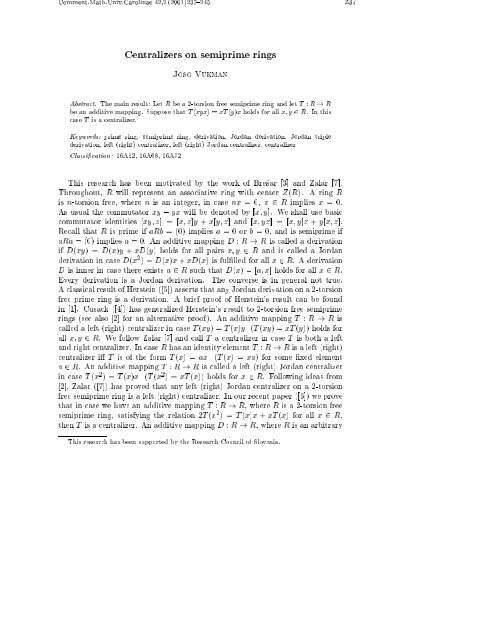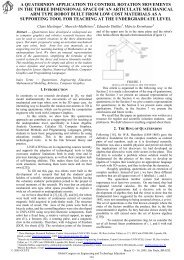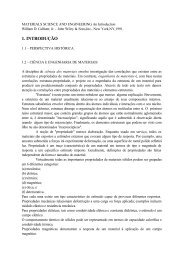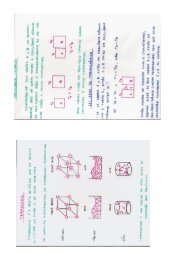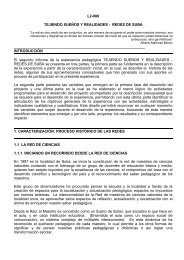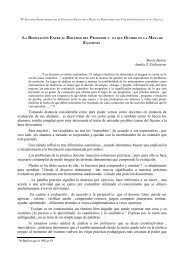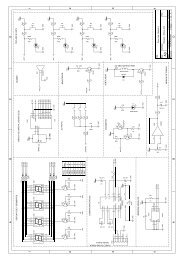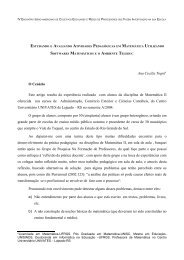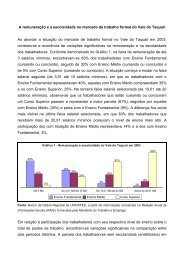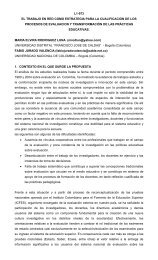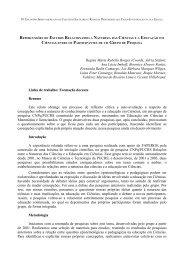âR. âR,
âR. âR,
âR. âR,
Create successful ePaper yourself
Turn your PDF publications into a flip-book with our unique Google optimized e-Paper software.
Comment.Math.Univ.Carolinae 42,2 (2001)237{245 237<br />
Centralizers on semiprime rings<br />
Joso Vukman<br />
Abstract. The main result: Let R be a 2-torsion free semiprime ring and let T : R ! R<br />
be an additive mapping. Suppose that T (xyx) =xT (y)x holds for all x; y 2 R. In this<br />
case T is a centralizer.<br />
Keywords: prime ring, semiprime ring, derivation, Jordan derivation, Jordan triple<br />
derivation, left (right) centralizer, left (right) Jordan centralizer, centralizer<br />
Classication: 16A12, 16A68, 16A72<br />
This research has been motivated by the work of Bresar [3] and Zalar [7].<br />
Throughout, R will represent an associative ring with center Z(R). A ring R<br />
is n-torsion free, where n is an integer, in case nx = 0, x 2 R implies x = 0.<br />
As usual the commutator xy , yx will be denoted by [x; y]. We shall use basic<br />
commutator identities [xy; z] = [x; z]y + x[y; z] and [x; yz] = [x; y]z + y[x; z].<br />
Recall that R is prime if aRb = (0) implies a =0orb = 0, and is semiprime if<br />
aRa = (0) implies a =0. An additive mapping D : R ! R is called a derivation<br />
if D(xy) = D(x)y + xD(y) holds for all pairs x; y 2 R and is called a Jordan<br />
derivation in case D(x 2 )=D(x)x + xD(x) is fullled for all x 2 R. A derivation<br />
D is inner in case there exists a 2 R such that D(x) =[a; x] holds for all x 2 R.<br />
Every derivation is a Jordan derivation. The converse is in general not true.<br />
A classical result of Herstein ([5]) asserts that any Jordan derivation on a 2-torsion<br />
free prime ring is a derivation. A brief proof of Herstein's result can be found<br />
in [1]. Cusack ([4]) has generalized Herstein's result to 2-torsion free semiprime<br />
rings (see also [2] for an alternative proof). An additive mapping T : R ! R is<br />
called a left (right) centralizer in case T (xy) =T (x)y (T (xy) =xT (y)) holds for<br />
all x; y 2 R. We follow Zalar [7] and call T a centralizer in case T is both a left<br />
and right centralizer. In case R has an identity element T : R ! R is a left (right)<br />
centralizer i T is of the form T (x) = ax (T (x) = xa) for some xed element<br />
a 2 R. An additive mapping T : R ! R is called a left (right) Jordan centralizer<br />
in case T (x 2 )=T (x)x (T (x 2 )=xT (x)) holds for x 2 R. Following ideas from<br />
[2], Zalar ([7]) has proved that any left (right) Jordan centralizer on a 2-torsion<br />
free semiprime ring is a left (right) centralizer. In our recent paper ([6]) we prove<br />
that in case we have an additive mapping T : R ! R, where R is a 2-torsion free<br />
semiprime ring, satisfying the relation 2T (x 2 ) = T (x)x + xT (x) for all x 2 R,<br />
then T is a centralizer. An additive mapping D : R ! R, where R is an arbitrary<br />
This research has been supported by the Research Council of Slovenia.
238 J. Vukman<br />
ring, is a Jordan triple derivation in case D(xyx) =D(x)yx + xD(y)x + xyD(x)<br />
holds for all pairs x; y 2 R. One can easily prove that any Jordan derivation is a<br />
Jordan triple derivation (see [1]). Bresar ([3]) has proved that any Jordan triple<br />
derivation on 2-torsion free semiprime ring is a derivation.<br />
If T : R ! R is a centralizer, where R is an arbitrary ring, then T satises the<br />
relation<br />
(1) T (xyx) =xT (y)x; x; y 2 R:<br />
It seems natural to ask whether the converse is true. More precisely, we are asking<br />
whether an additive mapping T on a ring R satisfying relation (1) is a centralizer.<br />
It is our aim in this paper to prove that the answer is armative in case R is<br />
a 2-torsion free semiprime ring. The proof of the theorem below is rather long,<br />
but it is elementary in the sense that it requires no specic knowledge concerning<br />
semiprime ring theory in order to follow the proof.<br />
Theorem 1. Let R be a 2-torsion free semiprime ring and let T : R ! R be an<br />
additive mapping. Suppose that T (xyx) =xT (y)x holds for all pairs x; y 2 R. In<br />
this case T is a centralizer.<br />
For the proof of the result above we shall need the lemma below, which is<br />
suggested by Lemma 4 in [2].<br />
Lemma 1. Let R be a semiprime ring. Suppose that the relation axb + bxc =0<br />
holds for all x 2 R and some a; b; c 2 R. In this case (a + c)xb =0is satised for<br />
all x 2 R.<br />
Proof: Putting xby for x in the relation below<br />
(2) axb + bxc =0; x 2 R;<br />
we obtain<br />
(3) axbyb + bxbyc =0; x; y 2 R:<br />
On the other hand right multiplication by yb of (2) gives<br />
(4) axbyb + bxcyb =0; x; y 2 R:<br />
Subtracting (4) from (3) we obtain<br />
(5) bx(byc , cyb) =0; x; y 2 R:<br />
The substitution ycx for x in (5) gives<br />
(6) bycx(byc , cyb) =0; x; y 2 R:
Centralizers on semiprime rings 239<br />
Left multiplication by cy of (5) gives<br />
(7) cybx(byc , cyb) =0; x; y 2 R:<br />
Subtracting (7) from (6) we obtain<br />
(byc , cyb)x(byc , cyb) =0; x; y 2 R;<br />
which gives byc = cyb, y 2 R. Therefore bxc can be replaced by cxb in (2), which<br />
gives (a + c)xb =0,x 2 R. The proof is complete.<br />
<br />
Proof of Theorem 1: We intend to prove the relation<br />
(8) [T (x);x]=0;x2 R:<br />
For the proof of the above relation we shall need the weaker relation below<br />
(9) [[T (x);x];x]=0; x 2 R;<br />
Putting x + z for x in relation (1) (linearization), we obtain<br />
(10) T (xyz + zyx) =xT (y)z + zT(y)x; x; y; z 2 R:<br />
Putting y = x and z = y in (10) one obtains<br />
(11) T (x 2 y + yx 2 )=xT (x)y + yT(x)x; x; y 2 R:<br />
For z = x 3 relation (10) reduces to<br />
(12) T (xyx 3 + x 3 yx) =xT (y)x 3 + x 3 T (y)x; x; y 2 R:<br />
Putting xyx for y in (11) we obtain<br />
(13) T (xyx 3 + x 3 yx) =xT (x)xyx + xyxT (x)x; x; y 2 R:<br />
The substitution x 2 y + yx 2 for y in relation (1) gives<br />
which gives because of (11)<br />
T (xyx 3 + x 3 yx) =xT (x 2 y + yx 2 )x; x; y 2 R;<br />
(14) T (x 3 yx + xyx 3 )=x 2 T (x)yx + xyT (x)x 2 ; x; y 2 R:<br />
Combining (13) with (14) we arrive at<br />
(15) x[T (x);x]yx , xy[T (x);x]x =0; x; y 2 R:
240 J. Vukman<br />
From the above relation and Lemma 1 it follows that<br />
(16) [[T (x);x];x]yx =0; x; y 2 R:<br />
Let y be y[T (x);x] in (16). We have<br />
(17) [[T (x);x];x]y[T (x);x]x =0; x; y 2 R:<br />
Right multiplication of (16) by [T (x);x] gives<br />
(18) [[T (x);x];x]yx[T (x);x]=0; x; y 2 R:<br />
Subtracting (18) from (17) one obtains [[T (x);x];x]y[[T (x);x];x]=0,x; y 2 R,<br />
and (9) follows by semiprimeness of R. The next step is the relation<br />
(19) x[T (x);x]x =0; x 2 R:<br />
The linearization of (9) gives<br />
[[T (x);x];y]+[[T (x);y];x]+[[T (y);y];x]+[[T (y);x];y]<br />
+[[T (x);y];y]=0; x; y 2 R:<br />
Putting ,x for x in the above relation and comparing the relation so obtained<br />
with the above relation we arrive at<br />
(20) [[T (x);x];y]+[[T (x);y];x]+[[T (y);x];x]=0; x; y 2 R:<br />
Putting xyx for y in (20) and using (1), (9) and (20) we obtain<br />
0=[[T (x);x];xyx]+[[T (x);xyx];x]+[[xT (y)x; x];x]<br />
= x[[T (x);x];y]x +[[T (x);x]yx + x[T (x);y]x + xy[T (x);x];x]<br />
+[x[T (y);x]x; x] =x[[T (x);x];y]x +[T (x);x][y; x]x + x[[T (x);y];x]x<br />
+x[y; x][T (x);x]+x[[T (y);x];x]x =[T (x);x][y; x]x + x[y; x][T (x);x]<br />
=[T (x);x]yx 2 , x 2 y[T (x);x]+xyx[T (x);x] , [T (x);x]xyx:<br />
We have therefore [T (x);x]yx 2 , x 2 y[T (x);x]+xyx[T (x);x] , [T (x);x]xyx =0,<br />
x; y 2 R, which reduces because of (9) and (15) to<br />
[T (x);x]yx 2 , x 2 y[T (x);x]=0; x; y 2 R:<br />
Left multiplication of the above relation by x gives<br />
x[T (x);x]yx 2 , x 3 y[T (x);x]=0; x; y 2 R:
Centralizers on semiprime rings 241<br />
One can replace in the above relation, according to (15), x[T (x);x]yx by<br />
xy[T (x);x]x, which gives<br />
(21) xy[T (x);x]x 2 , x 3 y[T (x);x]=0; x; y 2 R:<br />
Left multiplication of the above relation by T (x) gives<br />
(22) T (x)xy[T (x);x]x 2 , T (x)x 3 y[T (x);x]=0; x; y 2 R:<br />
The substitution T (x)y for y in (21) leads to<br />
(23) xT (x)y[T (x);x]x 2 , x 3 T (x)y[T (x);x]=0; x; y 2 R:<br />
Subtracting (23) from (22) we obtain<br />
[T (x);x]y[T (x);x]x 2 , [T (x);x 3 ]y[T (x);x]=0; x; y 2 R:<br />
From the above relation and Lemma 1 it follows that<br />
which reduces to<br />
([T (x);x 3 ] , [T (x);x]x 2 )y[T (x);x]=0; x; y 2 R;<br />
(x[T (x);x]x + x 2 [T (x);x])y[T (x);x]=0; x; y 2 R:<br />
Relation (9) makes it possible to write [T (x);x]x instead of x[T (x);x], which<br />
means that x 2 [T (x);x] can be replaced by x[T (x);x]x in the above relation. Thus<br />
we have<br />
x[T (x);x]xy[T (x);x]=0; x; y 2 R:<br />
Right multiplication of the above relation by x and substitution yx for y gives<br />
nally<br />
x[T (x);x]xyx[T (x);x]x =0; x; y 2 R;<br />
whence relation (19) follows. Next we prove the relation<br />
(24) x[T (x);x]=0; x 2 R:<br />
The substitution yx for y in (15) gives because of (19)<br />
(25) x[T (x);x]yx 2 =0; x; y 2 R:<br />
Putting yT(x) for y in the above relation we obtain<br />
(26) x[T (x);x]yT(x)x 2 =0; x; y 2 R:
242 J. Vukman<br />
Right multiplication of (25) by T (x) gives<br />
(27) x[T (x);x]yx 2 T (x) =0; x; y 2 R:<br />
Subtracting (27) from (26) we obtain x[T (x);x]y[T (x);x 2 ] =0,x; y 2 R which<br />
can be written in the form<br />
x[T (x);x]y([T (x);x]x + x[T (x);x]) = 0; x; y 2 R:<br />
According to (9) one can replace [T (x);x]x in the relation above by x[T (x);x],<br />
which gives x[T (x);x]yx[T (x);x] = 0, x; y 2 R, whence relation (24) follows.<br />
From (9) and (24) it follows that<br />
[T (x);x]x =0; x 2 R:<br />
From the above relation one obtains (see how relation (20) was obtained from (9))<br />
[T (x);x]y +[T (x);y]x +[T (y);x]x =0; x; y 2 R:<br />
Right multiplication of the above relation by [T (x);x] gives because of (24)<br />
[T (x);x]y[T (x);x]=0; x; y 2 R;<br />
which implies (8). Our next task is to prove the relation<br />
(28) T (xy + yx) =T (y)x + xT (y); x; y 2 R:<br />
In order to prove the above relation we need the relations below<br />
(29)<br />
(30)<br />
xA(x; y)x =0; x; y 2 R;<br />
[A(x; y);x]=0; x; y 2 R;<br />
where A(x; y) stands for T (xy + yx) , T (y)x , xT (y). Let us rst prove relation<br />
(29). The substitution xy + yx for y in (1) gives<br />
(31) T (x 2 yx + xyx 2 )=xT (xy + yx)x; x; y 2 R:<br />
On the other hand we obtain by putting z = x 2 in (10)<br />
(32) T (x 2 yx + xyx 2 )=xT (y)x 2 + x 2 T (y)x; x; y 2 R:<br />
By comparing (31) and (32) we arrive at (29). From (29) one obtains (see how<br />
(20) was obtained from (9))<br />
xA(x; y)z + xA(z; y)x + zA(x; y)x =0; x; y; z 2 R:
Centralizers on semiprime rings 243<br />
Right multiplication of the above relation by A(x; y)x gives because of (29)<br />
(33) xA(x; y)zA(x; y)x =0; x; y; z 2 R:<br />
Let us prove relation (30). The linearization of (8) gives<br />
(34) [T (x);y]+[T (y);x]=0; x; y 2 R:<br />
Putting xy+yx for y in the above relation and using (8) we obtain 0 = [T (x);xy+<br />
yx]+[T (xy + yx);x]=x[T (x);y]+[T (x);y]x +[T (xy + yx);x]. Thus we have<br />
[T (xy + yx);x]+x[T (x);y]+[T (x);y]x =0; x; y 2 R:<br />
According to (34) one can replace [T (x);y]by ,[T (y);x] in the above relation. We<br />
have therefore [T (xy + yx);x] , x[T (y);x] , [T (y);x]x = 0, which can be written<br />
in the form [T (xy + yx) , T (y)x , xT (y);x]=0. The proof of relation (30) is<br />
therefore complete. Relation (30) makes it possible to replace in (33) xA(x; y) by<br />
A(x; y)x. Thus we have<br />
(35) A(x; y)xzA(x; y)x =0; x; y 2 R;<br />
whence it follows that<br />
(36) A(x; y)x =0; x; y 2 R:<br />
Of course we have also<br />
(37) xA(x; y) =0; x; y 2 R:<br />
The linearization of (36) with respect to x gives<br />
A(x; y)z + A(z; y)x =0; x; y; z 2 R:<br />
Right multiplication of the above relation by A(x; y) gives because of (37)<br />
A(x; y)zA(x; y) =0; x; y; z 2 R;<br />
which gives A(x; y) =0,x; y 2 R. The proof of relation (28) is therefore complete.<br />
In particular for y = x relation (30) reduces to<br />
2T (x 2 )=T (x)x + xT (x); x 2 R:<br />
Combining the above relation with (8) we arrive at<br />
and<br />
T (x 2 )=T (x)x; x 2 R;<br />
T (x 2 )=xT (x); x 2 R:<br />
By Proposition 1.4 in [7] it follows that T is a left and also right centralizer, which<br />
completes the proof of the theorem.<br />
<br />
Putting (1) y = x in relation (1) we obtain<br />
(38) T (x 3 )=xT (x)x; x 2 R:<br />
The question arises whether in a 2-torsion free semiprime ring the above relation<br />
implies that T is a centralizer. Unfortunately, wewere unable to answer this question<br />
in general. However, we succeeded in proving that the answer is armative<br />
in case R has an identity element.
244 J. Vukman<br />
Theorem 2. Let R be a 2-torsion free semiprime ring with an identity element<br />
and let T : R ! R be an additive mapping. Suppose that T (x 3 )=xT (x)x holds<br />
for all x 2 R. In this case T is a centralizer.<br />
Proof: Putting x+1 for x in relation (38), where 1 denotes the identity element,<br />
one obtains after some calculations<br />
3T (x 2 )+2T (x) =T (x)x + xT (x)+xax + ax + xa; x 2 R;<br />
where a stands for T (1). Putting ,x for x in the relation above and comparing<br />
the relation so obtained with the above relation we obtain<br />
(39) 6T (x 2 )=2T (x)x +2xT (x)+2xax; x; 2 R;<br />
and<br />
(40) 2T (x) =ax + xa; x 2 R:<br />
We intend to prove that a 2 Z(R). According to (40) one can replace 2T (x) on<br />
the right side of (39) by ax+xa and 6T (x 2 ) on the left side by 3ax 2 +3x 2 a, which<br />
gives after some calculation<br />
ax 2 + x 2 a , 2xax =0; x 2 R:<br />
The above relation can be written in the form<br />
(41) [[a; x];x]=0; x 2 R:<br />
The linearization of the above relation gives<br />
(42) [[a; x];y]+[[a; y];x]=0; x; y 2 R:<br />
Putting xy for y in (42) we obtain because of (41) and (42) 0 = [[a; x];xy]+<br />
[[a; xy];x]=[[a; x];x]y+x[[a; x];y]+[[a; x];y]+x[[a; y];x]=x[[a; x];y]+[[a; x];x]y+<br />
[a; x][y; x]+x[[a; y];x]=[a; x][y; x]. Thus we have<br />
[a; x][y; x] =0;x;y 2 R:<br />
The substitution ya for y in the above relation gives<br />
[a; x]y[a; x] =0; x; y 2 R;<br />
whence it follows a 2 Z(R), which reduces (40) to the form T (x) =ax, x 2 R.<br />
The proof of the theorem is complete.<br />
<br />
We conclude with the following conjecture: Let R be a semiprime ring with<br />
suitable torsion restrictions. Suppose there exists an additive mapping T : R ! R<br />
such that T (x m+n+1 )=x m T (x)x n holds for all x 2 R where m 1, n 1 are<br />
some integers. In this case T is a centralizer.<br />
Acknowledgment. The author wishes to express thanks to the referee for helpful<br />
suggestions.
Centralizers on semiprime rings 245<br />
References<br />
[1] Bresar M., Vukman J., Jordan derivations on prime rings, Bull. Austral. Math. Soc. 37<br />
(1988), 321{322.<br />
[2] Bresar M., Jordan derivations on semiprime rings, Proc. Amer. Math. Soc. 104 (1988),<br />
1003{1006.<br />
[3] Bresar M., Jordan mappings of semiprime rings, J. Algebra 127 (1989), 218{228.<br />
[4] Cusack J., Jordan derivations on rings, Proc. Amer. Math. Soc. 53 (1975), 321{324.<br />
[5] Herstein I.N., Jordan derivations of prime rings, Proc. Amer. Math. Soc. 8 (1957), 1104{<br />
1110.<br />
[6] Vukman J., An identity related to centralizers in semiprime rings, Comment. Math. Univ.<br />
Carolinae 40 (1999), 447{456.<br />
[7] Zalar B., On centralizers of semiprime rings, Comment. Math. Univ. Carolinae 32 (1991),<br />
609{614.<br />
Department of Mathematics, University of Maribor, PEF, Koroska 160, Slovenia<br />
(Received January 10, 2000)


